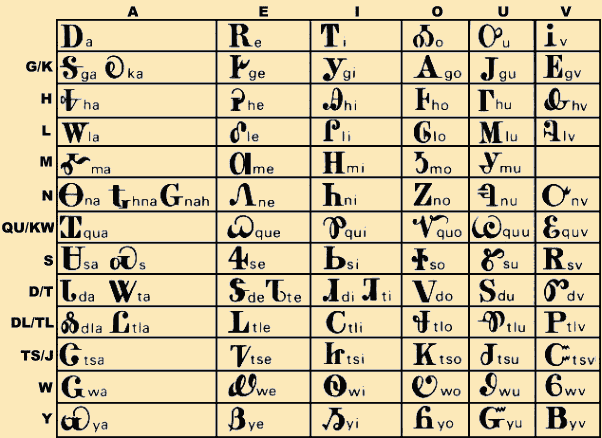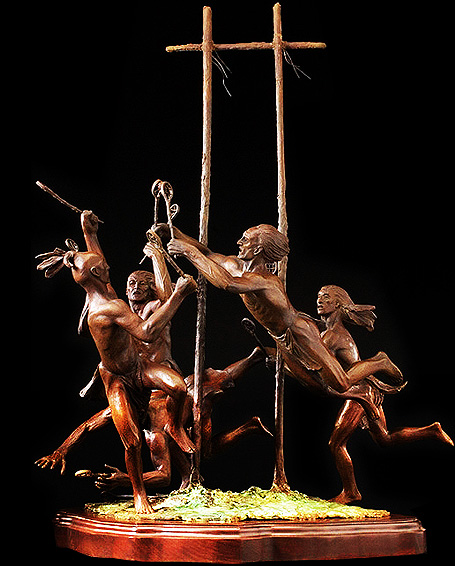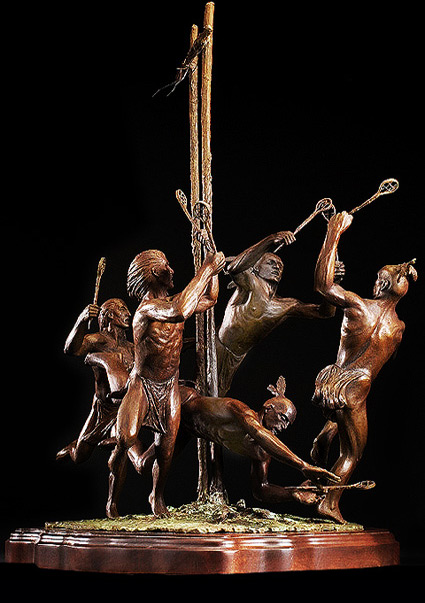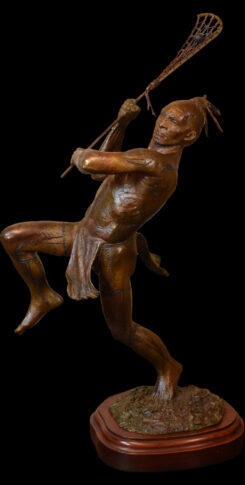
Bronze edition: 25 | Length: 30″
“Lacrosse is deeply rooted in the mythology and oral histories of the tribes that played the game. The early Jesuits appear to have been aware that a lacrosse match was a highly ceremonialized religious expression. Success or failure was attributable more to the prowess of the religious leaders who controlled players and games at every turn. The shaman acted somewhat like todays coaches but with an arsenal of magic powers to control the games’ outcome. The sacred nature of lacrosse explains the paramount role of the medicine man in all of it’s ritual aspects. The whole affair takes the aspect of a contest between the occult powers of the two medicine men…and the victory or defeat is laid at the door of the medicine men rather than the players.”
James Mooney describing an eastern Cherokee ballgame. (c.1888)
“New restrictions about 1848 on the older Cherokee game outlawed choking and breaking heads or limbs when excited.”
Excerpted from: American Indian Lacrosse, Tom Vennum, (1994)
“The Cherokee conjurors used magic spells and paraphernalia to weaken opponents or to make their team invincible to insure victory. Prior to the end of the 18th c. Cherokee shaman accompanied warriors who counted on them to divine the enemies strength and deliberate on strategy. During lacrosse matches in North Georgia, George White (c.1840) could easily identify the conjurors, whom he took to be over 100 yrs. old, on the sidelines holding shells, bones of snakes, etc for divination. When I spoke to one of them he did not deign to even raise his head and when I spoke the second time he gave me a terrific look. Certain lacrosse balls held objects hidden inside, invisible to opponents. Through sympathetic magic the properties of these parts of birds or animals were transferred to the ball itself. Similarly the sticks were doctored with special medicine and ritual immersion of the sticks in rivers by the assembled team was common. Another way the sticks received power was through the ballplay dance the night before the match – similar to preparations for the warpath. A keen eye was kept on the talent displayed on the lacrosse field and warriors were selected from the best players. The energy, dexterity, speed and endurance that enabled one to score against an opponent were the same attributes that prepared one for success in warfare.
“Much leisure time was devoted to games and nearly all were wagered on. Clearly the act of betting was more important than the monetary value of the items won or lost for it made them active participants of the contest. From earliest Jesuit accounts (1630’s) the high amount of wagers was noted but they stressed the dispassion of the losers. The desire to acquire superfluous material possessions was foreign to native people. No matter how high the stakes, the matter of winning or losing was relatively unimportant. As the artist George Catlin (who witnessed and painted Choctaw ballgames in the 1830’s) put it, ‘Oh, how I love a people who do not live for the love of money.’
“The Southeastern form of lacrosse played by Cherokee, Choctaw and Creek tribes, differed from the two Northern variations of the Great Lakes and the Iroquois in that it was the only double – stick form of the game. Players carry the ball cupped between the two sticks. Early accounts suggest that the ability to catch the ball in mid-air with two sticks was common: the players could throw the ball 100 yds. and it was in the air most of the time.”
James Adair (c. 1775)
“One can readily comprehend the degree of stamina required of successful ballplayers.”
Fogelson (c. 1962)
“Individualism, as in warfare, characterized the game – luck (magic?) and individual skill were key.
“That the game was physically rough, there is little doubt. The principle means of tying up one’s opponent is to grab from behind around the waist invariably leading both players to drop their sticks and indulge in a wrestling match. Sometimes 8 or 10 pairs are engaged in personal conflicts, each individual striving in the most vigorous and adroit manner to gain the mastery. A stranger will shudder to see the violent manner in which they throw each other to the ground.”
I. P. Evans (c.1820)
“Such wrestling may result in a mass pile-up presenting as they struggle for the ball, the appearance of a dozen gladiators striving to overcome a monster serpent.”
Lanman (c. 1848)
“The toll of energy striving to free oneself or keep an opponent from getting free spent in these exertions with ones opponent is tremendous. Add to this the constant pulling and tugging, the fact that the player must periodically sprint long distances at top speed, and one can readily comprehend the degree of stamina required of successful ballplayers.”
Fogelson (c. 1962)
“This game is so violent that they tear their skins and break their legs very often in striving to raise the ball.”
Baron Lahontan (c..1700)
“Any number of physical maneuvers that would today draw fouls were permitted: tackling, wrestling, tripping, charging, ramming, slashing and striking with a stick. Before I witnessed an Indian ballplay, I did not know that the vertebral column possessed as great a degree of flexibility as was demonstrated on such occasions. The principal respitory tube is handled in such an uncourteous manner, that the jaws open involuntarily, followed by a protrusion of the tongue.”
I.P. Evans (c. 1820)
“New restrictions about 1848 on the older Cherokee game outlawed choking and breaking heads or limbs when excited.”
Excerpted from: American Indian Lacrosse, Tom Vennum, (1994)
Footnote: The symbols below the heading, is the translation of “A Cherokee Ballgame” using Sequoya’s (an important figure in Cherokee tribal history) syllabary which he invented about 1828. See all 84 symbols below:







